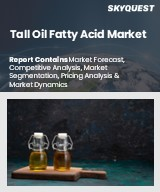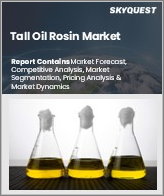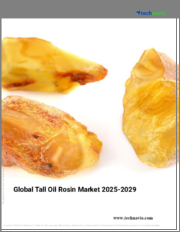
|
시장보고서
상품코드
1770781
톨유 지방산 시장 규모, 점유율, 성장 분석 : 제품별, 용도별, 최종사용자별, 지역별 - 산업 예측(2025-2032년)Tall Oil Fatty Acid Market Size, Share, and Growth Analysis, By Product (Oleic Acid, Linoleic Acid), By Application (Asphalt Emulsions, Detergents), By End Users, By Region - Industry Forecast 2025-2032 |
||||||
톨유 지방산 세계 시장 규모는 2023년에 34억 달러로 평가되었으며, 2024년 36억 1,000만 달러에서 2032년에는 58억 9,000만 달러로 성장하여 예측 기간(2025-2032년) 동안 CAGR 6.3%로 성장할 전망입니다.
세계 톨유 지방산 시장은 급속한 산업화와 기술 발전으로 바이오 기반 소재에 대한 수요가 증가함에 따라 호황을 누리고 있습니다. 기업들은 그린 케미스트리와 순환 경제를 중시하는 추세에 따라 석유화학에서 재생 가능한 원료, 특히 톨유 지방산으로 전환하고 있습니다. 이들 지방산은 화학, 페인트, 윤활유, 세제 등 다양한 분야에서 응용되고 있습니다. 특히 Arizona Chemicals와 같은 혁신적인 기업들은 톨유 지방산을 함유한 친환경 페인트를 출시하여 지속가능성 목표를 지원하고 있습니다. 또한, 이 산업은 AI, 머신러닝, IoT, 블록체인 기술의 통합을 통해 생산 효율성을 높이고, 책임 있는 조달을 보장하며, 가상현실을 통한 교육을 제공하는 등 진화하고 있습니다. 이러한 기술의 융합을 통해 기업들은 시장에서의 경쟁력을 높이고 있습니다.
목차
소개
- 조사 목적
- 조사 범위
- 정의
조사 방법
- 정보 조달
- 2차와 1차 데이터 방법
- 시장 규모 예측
- 시장 가정과 제한
주요 요약
- 세계 시장 전망
- 공급과 수요 동향 분석
- 부문별 기회 분석
시장 역학과 전망
- 시장 개요
- 시장 규모
- 시장 역학
- 성장 촉진요인과 기회
- 성장 억제요인과 과제
- Porters 분석
주요 시장 인사이트
- 핵심성공요인
- 경쟁 정도
- 주요 투자 기회
- 시장 생태계
- 시장 매력 지수(2024년)
- PESTEL 분석
- 거시경제 지표
- 밸류체인 분석
- 가격 분석
- 규제 분석
톨유 지방산 시장 규모 : 제품별 & CAGR(2025-2032년)
- 시장 개요
- 올레산
- 리놀레산
- 기타
톨유 지방산 시장 규모 : 용도별 & CAGR(2025-2032년)
- 시장 개요
- 아스팔트 에멀전
- 세제
- 연료 첨가제
- 액체 클리너
- 비누
- 플라스틱 첨가제
- 유전 화학제품
- 수지
- 기타
톨유 지방산 시장 규모 : 최종사용자별 & CAGR(2025-2032년)
- 시장 개요
- 건설
- 석유 및 가스
- 섬유
- 페인트와 코팅
- 기타
톨유 지방산 시장 규모 : 지역별 & CAGR(2025-2032년)
- 북미
- 미국
- 캐나다
- 유럽
- 독일
- 스페인
- 프랑스
- 영국
- 이탈리아
- 기타 유럽
- 아시아태평양
- 중국
- 인도
- 일본
- 한국
- 기타 아시아태평양
- 라틴아메리카
- 브라질
- 기타 라틴아메리카
- 중동 및 아프리카
- GCC 국가
- 남아프리카공화국
- 기타 중동 및 아프리카
경쟁 정보
- 상위 5개사의 비교
- 주요 기업의 시장 포지셔닝(2024년)
- 주요 시장 기업이 채용한 전략
- 최근의 시장 동향
- 기업의 시장 점유율 분석(2024년)
- 주요 기업 개요
- 기업 상세
- 제품 포트폴리오 분석
- 기업 부문별 점유율 분석
- 매출 전년비 비교(2022-2024년)
주요 기업 개요
- PineChemical Group Oy(Finland)
- Forchem Oyj(Finland)
- Kraton Corporation(US)
- Ilim Group JSC(Russia)
- Harima Chemicals, Inc(Japan)
- Eastman Chemical Company(US)
- Lascaray S.A.(Spain)
- Lintech International LLC
- BASF SE
- Shaxian Lixin Resin Co. Ltd.
- Pasand Speciality Chemical
결론과 제안
ksm 25.07.21Global Tall oil fatty acid Market size was valued at USD 3.4 billion in 2023 and is poised to grow from USD 3.61 billion in 2024 to USD 5.89 billion by 2032, growing at a CAGR of 6.3% during the forecast period (2025-2032).
The global tall oil fatty acid market is thriving, driven by the increasing demand for bio-based materials amidst rapid industrialization and technological advancements. Companies are transitioning from petrochemical to renewable sources, notably tall oil fatty acids, aligning with the growing emphasis on green chemistry and a circular economy. These fatty acids are finding applications across various sectors, including chemicals, paints, lubricants, and detergents. Notably, innovative firms like Arizona Chemicals are launching eco-friendly paints formulated with tall oil fatty acids, supporting sustainability objectives. Furthermore, the industry is evolving with the integration of AI, machine learning, IoT, and blockchain technology, enhancing production efficiency and ensuring responsible sourcing while providing training through virtual reality. This convergence of technology is positioning companies competitively in the market.
Top-down and bottom-up approaches were used to estimate and validate the size of the Global Tall oil fatty acid market and to estimate the size of various other dependent submarkets. The research methodology used to estimate the market size includes the following details: The key players in the market were identified through secondary research, and their market shares in the respective regions were determined through primary and secondary research. This entire procedure includes the study of the annual and financial reports of the top market players and extensive interviews for key insights from industry leaders such as CEOs, VPs, directors, and marketing executives. All percentage shares split, and breakdowns were determined using secondary sources and verified through Primary sources. All possible parameters that affect the markets covered in this research study have been accounted for, viewed in extensive detail, verified through primary research, and analyzed to get the final quantitative and qualitative data.
Global Tall oil fatty acid Market Segments Analysis
Global Tall oil fatty acid Market is segmented by Product, Application, End Users and region. Based on Product, the market is segmented into Oleic Acid, Linoleic Acid and Others. Based on Application, the market is segmented into Asphalt Emulsions, Detergents, Fuel Additives, Liquid Cleaners, Soaps, Plastic Additives, Oilfield Chemicals, Resins and Others. Based on End Users, the market is segmented into Construction, Oil & Gas, Textiles, Paints & Coatings and Others. Based on region, the market is segmented into North America, Europe, Asia Pacific, Latin America and Middle East & Africa.
Driver of the Global Tall oil fatty acid Market
The global market for tall oil fatty acids is witnessing a transformation driven by the increasing demand for sustainable, bio-based chemicals, which is largely influenced by stringent regulatory frameworks and heightened consumer awareness. As a result, there is a swift adoption of tall oil fatty acids, recognized for their biodegradable and non-toxic properties. This transition is not only essential for meeting compliance standards but is also pivotal in shaping brand identity and aligning with consumer preferences. Additionally, companies are prioritizing ESG (Environmental, Social, and Governance) compliance, leading to significant improvements in supply chains to integrate more environmentally-friendly alternatives.
Restraints in the Global Tall oil fatty acid Market
The global tall oil fatty acid market encounters significant constraints related to the production process, which relies heavily on the craft pulping method using pine timber. This timber is often scarce in tropical regions, resulting in inconsistent availability of raw materials and creating imbalances in supply and demand. Additionally, the market is affected by price volatility stemming from transportation costs and fluctuations in currency exchange rates, which introduces uncertainty for manufacturers. Furthermore, stringent government regulations and advocacy from environmental groups against deforestation hinder the harvesting of pine trees, further compounding the challenges associated with raw material scarcity in this industry.
Market Trends of the Global Tall oil fatty acid Market
The global tall oil fatty acid market is experiencing a significant trend towards supply chain optimization by market leaders, driven by the limited domestic production of tall oil fatty acids in numerous countries due to the scarcity of specific pine timber and kraft process production facilities. This has led to an increased reliance on imports, prompting companies to streamline their supply chains to ensure a steady supply of raw materials, effectively reduce production costs, and maintain consistent product quality. By integrating advanced technologies such as digital tracking, logistical enhancements, and strategic storage solutions, these firms are not only ensuring ethical sourcing but also bolstering product consistency, ultimately enhancing their competitive edge in the market.
Table of Contents
Introduction
- Objectives of the Study
- Scope of the Report
- Definitions
Research Methodology
- Information Procurement
- Secondary & Primary Data Methods
- Market Size Estimation
- Market Assumptions & Limitations
Executive Summary
- Global Market Outlook
- Supply & Demand Trend Analysis
- Segmental Opportunity Analysis
Market Dynamics & Outlook
- Market Overview
- Market Size
- Market Dynamics
- Drivers & Opportunities
- Restraints & Challenges
- Porters Analysis
- Competitive rivalry
- Threat of substitute
- Bargaining power of buyers
- Threat of new entrants
- Bargaining power of suppliers
Key Market Insights
- Key Success Factors
- Degree of Competition
- Top Investment Pockets
- Market Ecosystem
- Market Attractiveness Index, 2024
- PESTEL Analysis
- Macro-Economic Indicators
- Value Chain Analysis
- Pricing Analysis
- Regulatory Analysis
Global Tall oil fatty acid Market Size by Product & CAGR (2025-2032)
- Market Overview
- Oleic Acid
- Linoleic Acid
- Others
Global Tall oil fatty acid Market Size by Application & CAGR (2025-2032)
- Market Overview
- Asphalt Emulsions
- Detergents
- Fuel Additives
- Liquid Cleaners
- Soaps
- Plastic Additives
- Oilfield Chemicals
- Resins
- Others
Global Tall oil fatty acid Market Size by End Users & CAGR (2025-2032)
- Market Overview
- Construction
- Oil & Gas
- Textiles
- Paints & Coatings
- Others
Global Tall oil fatty acid Market Size & CAGR (2025-2032)
- North America (Product, Application, End Users)
- US
- Canada
- Europe (Product, Application, End Users)
- Germany
- Spain
- France
- UK
- Italy
- Rest of Europe
- Asia Pacific (Product, Application, End Users)
- China
- India
- Japan
- South Korea
- Rest of Asia-Pacific
- Latin America (Product, Application, End Users)
- Brazil
- Rest of Latin America
- Middle East & Africa (Product, Application, End Users)
- GCC Countries
- South Africa
- Rest of Middle East & Africa
Competitive Intelligence
- Top 5 Player Comparison
- Market Positioning of Key Players, 2024
- Strategies Adopted by Key Market Players
- Recent Developments in the Market
- Company Market Share Analysis, 2024
- Company Profiles of All Key Players
- Company Details
- Product Portfolio Analysis
- Company's Segmental Share Analysis
- Revenue Y-O-Y Comparison (2022-2024)
Key Company Profiles
- PineChemical Group Oy (Finland)
- Company Overview
- Business Segment Overview
- Financial Updates
- Key Developments
- Forchem Oyj (Finland)
- Company Overview
- Business Segment Overview
- Financial Updates
- Key Developments
- Kraton Corporation (US)
- Company Overview
- Business Segment Overview
- Financial Updates
- Key Developments
- Ilim Group JSC (Russia)
- Company Overview
- Business Segment Overview
- Financial Updates
- Key Developments
- Harima Chemicals, Inc (Japan)
- Company Overview
- Business Segment Overview
- Financial Updates
- Key Developments
- Eastman Chemical Company (US)
- Company Overview
- Business Segment Overview
- Financial Updates
- Key Developments
- Lascaray S.A. (Spain)
- Company Overview
- Business Segment Overview
- Financial Updates
- Key Developments
- Lintech International LLC
- Company Overview
- Business Segment Overview
- Financial Updates
- Key Developments
- BASF SE
- Company Overview
- Business Segment Overview
- Financial Updates
- Key Developments
- Shaxian Lixin Resin Co. Ltd.
- Company Overview
- Business Segment Overview
- Financial Updates
- Key Developments
- Pasand Speciality Chemical
- Company Overview
- Business Segment Overview
- Financial Updates
- Key Developments




















